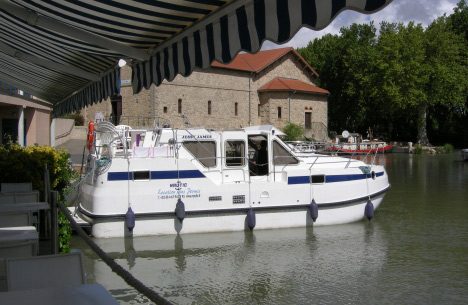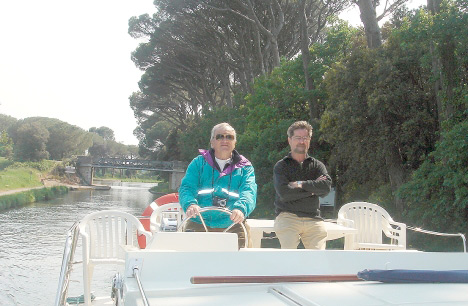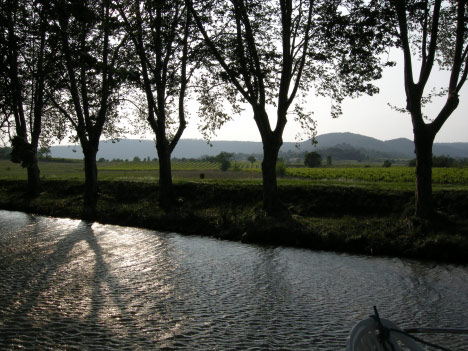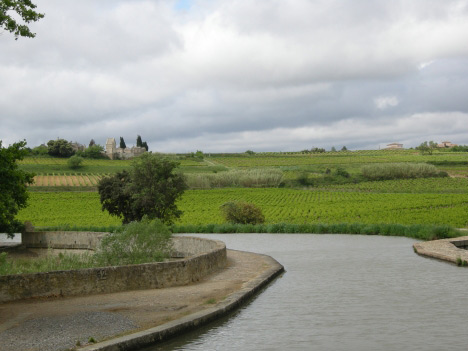 |
| With the Jessy James through the Languedoc vineyards |
Actually, it is not vineyards, but large, wide vineyards that are crossed by the "Canal du Midi", in many twists and loops, 240 kilometres long, from Toulouse to Marseillan. You enter the famous appellations of the Languedoc quietly chugging along, many of them are only touched on the edge or widely bypassed, because they are located on slopes or even in the mountains.
A journey by "houseboat" through the Languedoc is something like a love affair in the middle of a nature populated by gnarled, mostly quite old vines. They are exposed to the weather and the wind - especially the Mistral and the Tramontane - but also to the Mediterranean sun, the warm or even hot burning climate. The mountains in the north and the hills on the coast are hardly able to protect the flora. Anyone travelling on the motorway through the Rhône valley or by TGV from Lyon to the "Canal du Midi" in the "Pay d'oc" is re-educated at a stroke from the "Grande Vitesse" to slowness, from a hundred and thirty or more kilometres an hour to walking pace, four to ten kilometres an hour at the most.
 |
| Slowness: a new experience with plenty of time for contemplation |
The journey up the canal allows the wine lover a leisurely approach to different climates of a landscape that produces wines in large quantities, increasingly also of excellent quality. Wines that have long since ceased to be merely "vins de table" - simple table or country wines. Even the simplest wines increasingly reveal their special, Mediterranean climate, their terroir on a soil of marl, boulders and alluvial soil, as it can be experienced and understood at first hand on a boat trip through the vines.
Now in spring - after a winter that was also quite mild here - the dark brown, almost black vines - which were pruned back to the "trunk" in winter - turn into a bright green sea of plants that shine far and wide, just waiting to grow to produce blossoms and later grapes.
 |
| Romantic atmosphere along the almost endless plane tree avenue |
Leisurely, although no longer pulled by horses on the towpath, but driven by an engine, which is throttled and muffled noise hardly noticeable, a landscape is crossed, which changes slowly, but clearly, from a rather mild sea climate, dipped in blue haze and smelling of salt water, to a harsh, sun-baked, wind-swept region, defying the forces of nature, which can give warmth and strength to vegetation now in spring, but in two or three months will only be able to nourish the strongest plants: these are the vines, the plane trees, the cypresses, and ever increasing fields of garrigue (heather, undergrowth).
Here grows what is harvested in autumn and made into wine; what a large part of the population lives on, gives people income and earnings, but what they also love and are proud of. On this trip, a lot of the snobbery that we wine lovers often so cavalierly display, wrapping it up in nice-sounding descriptions, giving it marks and points, and always making sure to get only the very best for very little money, crumbled off me, too.
 |
| Canal du Midi: inaugurated in 1681% 240 kilometres long |
For me, the wines we drink on the boat in the evenings - almost always from the area we are passing through and only the best of the region (as a "wine connoisseur" you owe yourself something!) - have taken on a whole new, different character. They are no longer simply brilliantly made, superbly vinified, balanced in elements such as acidity, alcohol, fruit, flavor; they suddenly become a part of life that can only truly thrive here - in this landscape, in this climate, but also only in this culture and tradition. I'll talk about this a few more times in later columns.
Sincerely
Yours sincerely
Peter (Züllig)